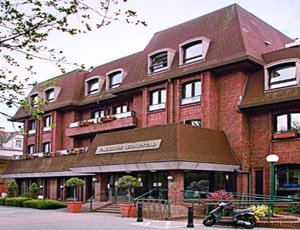The average cost of Brachytherapy in London approximately starts from USD 14000
Treatment cost

Apart from in-detail treatment procedures available, Parkside Private Hospital located in London, United Kingdom has a wide variety of facilities available for International Patients. Some of the facilities which are provided by them are Accommodation, Airport Transfer, Choice of Meals, Interpreter, SIM, TV inside room. Also listed below are some of the most prominent infrastructural details:

Brachytherapy is an advanced form of radiation therapy. It is also known as internal radiation therapy. Radiation therapy is a type of cancer treatment in which ionizing radiation is used to destroy cancer cells and shrink the size of the tumors. The conventional form of radiation therapy is external beam radiation that projects radiation from a machine outside of the body. In case of internal radiation or brachytherapy, radioactive particles or sources that are internally placed in or next to the tumour site, are used to destroy cancer cells. Brachytherapy helps deliver a high radiation dose to the tumor, with minimal exposure to the surrounding healthy tissues.It thus allows delivering high doses of radiation to more-specific areas of the body.
Brachytherapy can be used for effective treatment of cervical, prostate, breast, skin, lung, head and neck, and gum cancer, in addition to tumors located in other parts of the body. Brachytherapy for prostate cancer is a commonly performed procedure. It is also used for the treatment of gum cancer as well. Brachytherapy is an alternative treatment for gum cancer and is conducted who are unfit to undergo a surgery or do not need one.
Brachytherapy can be completed in less time than other conventional radiotherapy techniques. Brachytherapy for prostate cancer and other cancers is often performed on an outpatient basis and patients typically have to take fewer brachytherapy sessions, as compared to external radiotherapy treatment for cancer. This makes brachytherapy more accessible and convenient to many patients. Most of the patients are able to tolerate brachytherapy very well with fewer side effects.
There are two types of brachytherapy treatment:
Brachytherapy treatment plan is created and governed by a radiation oncologist, who is a highly trained physician specializing in treating cancer with radiotherapy. The radiation oncologist will require a team, including a medical physicist, dosimetrist, radiation therapist, radiation therapy nurse and in some cases, a surgeon to conduct the procedure. However, the radiation oncologist is the one who evaluates the patient and determines the appropriate therapy, including how much radiation to deliver.
In permanent brachytherapy, needles that are pre-filled with the radioactive brachytherapy seeds are inserted into the tumor. Then the needle or device is removed, leaving the radioactive seeds behind. Sometimes these seeds may be implanted in sessions using a device that inserts them individually at regular intervals. An appropriate imaging means such as an ultrasound, X-ray, MRI or CT scan may be used to assist the physician in positioning brachytherapy seeds at the right place. After implantation, some additional imaging can be done to verify seed placement.
Temporary brachytherapy starts with placing a delivery device, such as a catheter, needle, or applicator, into the tumor. Methods of imaging such as an ultrasound, MRI, or CT scan will help position the radiation sources correctly. The delivery device can either be inserted into a body cavity such as vagina (intracavitary brachytherapy) or applicators such as needles or catheters can be inserted into body tissues (interstitial brachytherapy). Device implantation will depend on the location of cancer.
Radiation using brachytherapy procedure can be delivered at three different levels:
For patients who have received brachytherapy for prostate cancer or any other types of cancer, limiting physical activity for at least three to five days is important. You can experience some level of grogginess after the procedure, however, it will last for only a few hours. You will be prescribed a few emergency medicines that you can take in case you experience pain or any other type of discomfort.
There are some side effects associated with all kinds of radiation therapy. However, the acute, sub-acute, or long-term side effects of brachytherapy depend on the location of the tumor being treated and the type of brachytherapy being used.
Some acute side effects of brachytherapy are
But these are temporary side effects and usually resolve within a few days following completion of treatment.
Usually, brachytherapy does not cause any long-term side effects, but in a few cases, it may cause urinary and digestive problems. But in that case as well, long-term side effects are usually mild or moderate in nature and there are many palliative medicines that are available to cope with the symptoms.
Ask your healthcare adviser for the best multiple options and choose the one that meets your expectations
On an average, Brachytherapy in London costs about $14000. Brachytherapy in London is available across many hospitals in different states.
The Brachytherapy package cost in London varies from one hospital to another and may offer different benefits. The top hospitals for Brachytherapy in London covers all the expenses related to the pre-surgery investigations of the candidate. Typically, the package cost of Brachytherapy in London includes the expenses related to the surgeon's fee, anesthesia, hospital, meals, nursing and ICU stay. Post-surgical complications, new findings and delayed recovery may have an impact on the total Brachytherapy cost in London.
Many hospitals in London perform Brachytherapy. The top hospitals for Brachytherapy in London include the following:
After discharge from the hospital, the patient has to stay for another 20 days in the country for complete recovery. This duration of stay is recommended to complete all the necessary follow-ups and control tests to ensure that the surgery was successful.
There are certain additional cost that the patient has to pay apart from the Brachytherapy cost. These are the charges for daily meals and accommodation outside the hospital. The per day cost in this case may range from 55 USD.
After Brachytherapy surgery, the patient is supposed to stay for about 1 Days in the hospital for recovery and monitoring. The doctors team review the patient's recovery during this time with the help of blood tests and imaging scans. Once they feel that everything is on track, the patient is discharged.
Out of all the hospitals in London, there are about 1 Hospitals best hospitals for Brachytherapy in London. These hospitals are approved to perform the surgery and have proper infrastructure to handle Brachytherapy patients. These hospitals comply with all the rules and regulations as dictated by the regulatory bodies and medical association in London
Some of the most sought after doctors for Brachytherapy in London are: